By Tom Darling, Conversations with Classic Boats
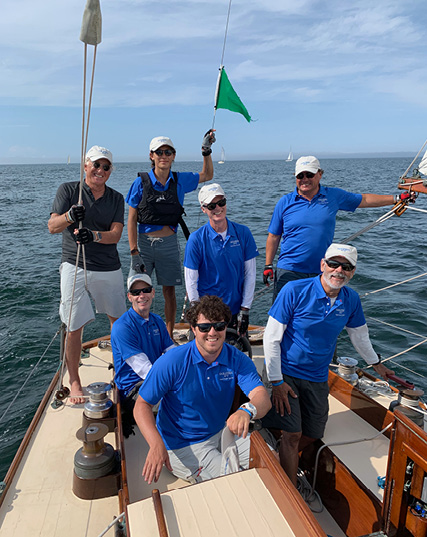
Our 2019 Dolphin crew enjoying the 103-year-old Herreshoff classic at the Opera House Cup
On the PBS program Antiques Roadshow, the hosts consider things fifty years or older to be vintage, antique. Proud owners of boats over 50 think similarly. What about the regattas they compete in? On August 21 in Nantucket Sound, there will be a new “Antiques Sailshow,” a celebration of the 50th running of the Nantucket segment of the Classic Yacht Owners Association season. It is the 50th Opera House Cup (OHC).
And the night before the OHC, classics fanciers will be able to attend a boat show seen nowhere else in America, the Classic Yacht Exhibition (CYE). The CYE is a Noah’s Ark of restored wooden boats from the best-known names in boat design: Stephens, Alden, Herreshoff, and more.
All of this started, like so many famous races, with a bar bet. In this case, it was at the Opera House, a long-gone watering hole run by Gwen Gaillard, a Nantucket hospitality legend. Gwen and Chick Walsh, another restaurateur, set the rules. The idea was a race for wooden boats only, with a handicap to be determined. The Opera House Cup Regatta was the first all-wooden, single-hulled classic boat regatta on the East Coast. Boats are now scored using the Classic Yacht Owners Association’s (CYOA) CRF rating system.
In a half-century of running a race, things change, though most things stay the same. The Opera House Cup is part of the CYOA Classic Yacht Series and is the grand finale of Nantucket Race Week. Since 1972, through hurricane and pandemic, the basic hallmarks of the OHC go on. Those are: The Course; The Current; The Finishing Leg; The Pre-race Sunday morning; and of course, the OHC Awards Party.
Let’s examine them in detail:
The Course: The traditional 20-mile-plus triangle in Nantucket Sound, scored under handicap, endured until 2020 when for several pandemic-related reasons, the pursuit format was established. Pursuit means big boats chase little boats. First boat to finish wins.
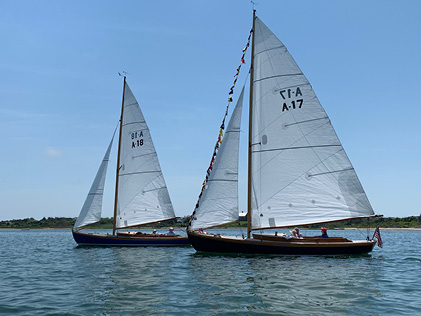
Nantucket Alerions ready to race
The Current: Nantucket Sound is a shallow basin (average 10 feet deep out of the ferry channel) of constantly moving water with paradoxical tides. The ebb and the flood seem mixed up to the visiting sailor; just remember ebb west, flood east.
But whatever current is showing on the buoys, the Opera House always seems to come down to the last leg.
The Finishing Leg: And what a leg it is, with champagne southerly windward work in the customary late afternoon Nantucket seabreeze. With a typical course, the final leg starts from an inflatable mark placed off Great Point Light with its Revolutionary War vintage white brick tower pointing toward the twin breakwaters into Nantucket Harbor; it is dead upwind in a smoky sou’wester. The race is often won or lost in that last seven miles. Now in a pursuit format, the drama is higher. First over to windward wins.
In the first pursuit start, used in a truncated 2020 OHC, the course set up in a 25-knot nor’easter resulting in a drag reach to the finish. The leader, a 26-foot Alerion, held her breath as two of the biggest boats, a so-called Spirit of Tradition Class Botin 55, a wooden TP52-like design, Outlier, and Wendy Schmidt’s 52-foot S&S gem Santana steadily ground down the little boat’s lead. Imagine the sound of 100 feet of collective waterline creeping up on you. But Mark Pagon, skipper of the virtually unpronounceable Alerion A-24 Scheherazade, held on for the win.
The last two elements of the OHC have nothing to do with the racing but everything to do with the Race, the Before and the After. First is the Pre-Race, involving something old, The Rainbow Parade, and in 2022 introducing something new, The Parade of Wooden Boats.
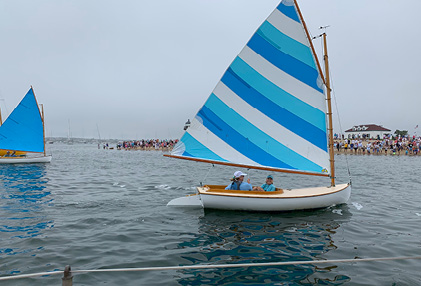
Rainbow catboats in the Pre-Race Parade
The Rainbow Fleet Parade: Almost fifty years before the first OHC, the little catboats of the Nantucket YC started the tradition of raising sail and parading round Brant Point, the compact white lighthouse at the juncture of Nantucket Harbor and the Channel north to Nantucket Sound. Because of their colored sails, the cats were dubbed “Rainbows.”
In 1921, NYC Vice Commodore Clarence Gennett had commissioned a design for a 16-foot catboat from W. D. Allen in Port Jefferson, NY. Allen was a descendent of Nantucket and New Bedford whaling captains. The first seven boats were delivered for the 1922 summer racing season. They cost $475.
(Source: Nantucket Historical Association, 2018 Catboat Study)
By the late ‘20s, a local artist named Gardner was selling tourists colored postcards of the catboats; he too dubbed them Rainbows. On the mainland, they would be Beetle Cats or Crosby Cats or some other local class. But on Nantucket, the name Rainbows has stuck.
In the 1970s, someone got the bright idea to take these Rainbows out the morning of the Opera House, watch the OHC fleet motor out and call it a parade. The Rainbow Parade engages all those on Nantucket with a leaky catboat to get it in the water for one day and keep it afloat for two hours. The Rainbows appear after 9am from every corner of Nantucket Harbor, then dodge race boats headed out the channel.
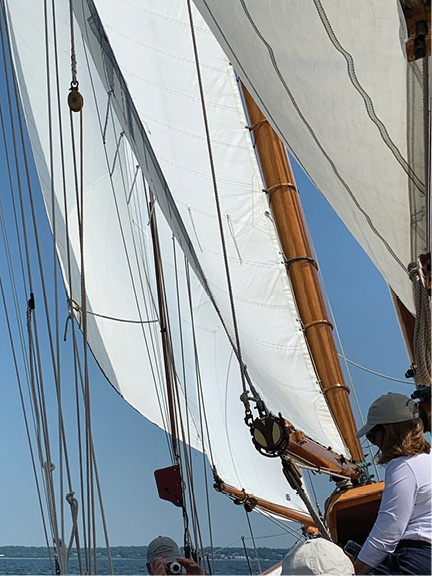
Visiting from her base at Mystic Seaport Museum, the 1932 S&S schooner Brilliant tripleslotting upwind
The Parade of Wooden Boats: Beginning this summer, the OHC Committee has started its own parade. This is an impressive effort to collect and showcase the five-dozen classic boats in the regatta. Up to 65 entries are expected to parade past Brant Point Light, with an announcer describing each one. Think of a golfer being announced on the first tee at Augusta. Viewers will have a program identifying entries by photo and description. Classics will still be dodging Rainbows! And vice versa.
This leaves the final event, one of the biggest reasons the OHC attracts sailors from around the Northeast and beyond.
The OHC Awards Party: Held on a public beach facing the Sound, the Party allows people to dig their toes into that Nantucket sand, sample the raw bar and in the past, drink, view race photos and wait for the results. This year’s event will have a whole new feel as pursuit winners are known by party times. No matter, the hardware is the hardware, and it is formidable. The most compelling incentive to win overall is the award of a hand-carved quarterboard with the boat’s name gilded. The offices of Nantucket Community Sailing, housed below a former 19th century boys’ school in Nantucket Town, are filled with the boards of the winners.
My own Nantucket sailing career and the OHC have gone hand in hand. I’ve had a quartet of OHC rides over the last twenty years. Prior to 2000, I was on Piera, an Abeking & Rasmussen-built cutter driven by a summer sailor who owned a pretzel company. When my daughter got old enough to ride in the rumble seat of Northern Light, the pre-WW II dark blue 12 Metre drawn by Stephens and built by Nevins, I was there part-time on the winches and part-time on her exhausting direct drive steering wheel that eats up helmsmen in a breeze.
I started poking my head into more competition in 2006 in the Nantucket Alerion Class. My skipper Brian Simmons had a new boat to that design, A-26, named First Tracks. He was a skier; boat racing was new to him. As the wind steadily built to 20, 25, 30, we stuck downwind to a team skippered by Gary Hoyt, a Pan Am Games winner. Then, with a solid 900 pounds of hiking weight, Hoyt’s Osprey blew by us and headed upwind for the overall win. We were second, and happy to be back in one piece. I still have the computer mouse pad with a local photographer’s picture showing a 26-foot Alerion leaping out of the water upwind on a huge wave that last leg.
In 2015, Team Dolphin, our Alerion team supplemented with another six sailors, chartered the winningest boat in Northeast sailing history, the Newport 29 Dolphin. Between 2015 and 2018, we had a mélange of conditions for our three tries at the Cup; one light day, one medium day and one day blowing us off the deck. But we got to the podium once, contended always, and reveled in sailing a 100-year-old boat. What will we be sailing in 2022? My bet will be with Brian on First Tracks…
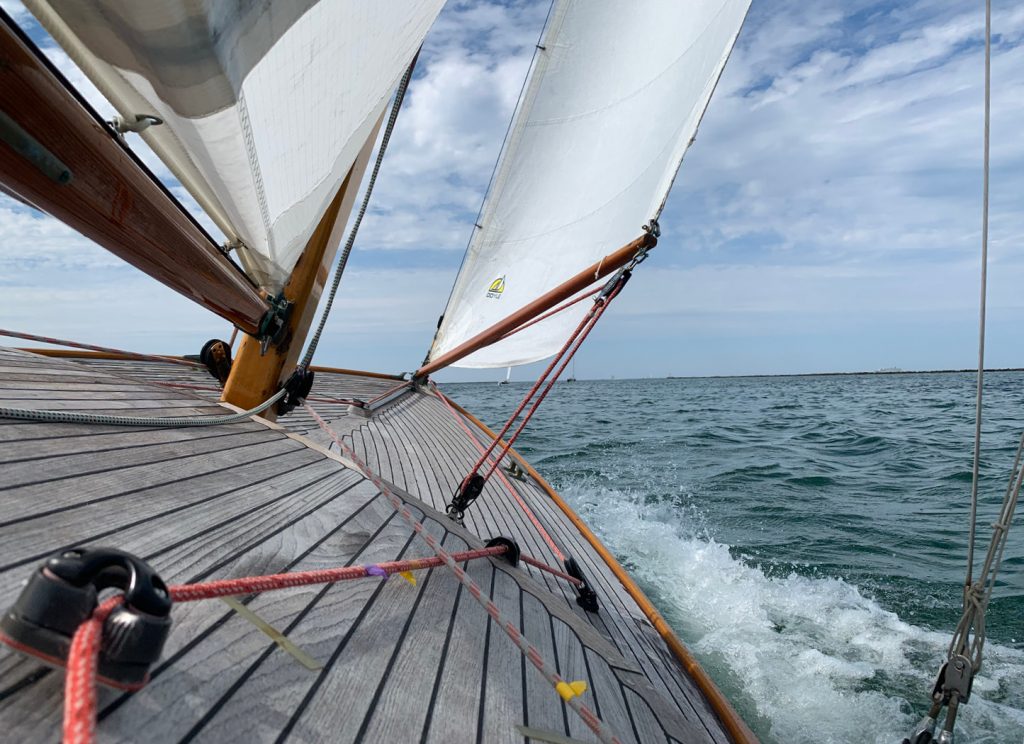
Aboard First Tracks
The Classic Yacht Exhibition: Noah’s Ark of the Classics
One of the most popular prerace activities comes Saturday night before the race and deserves a spotlight of its own. The Classic Yacht Exhibition collects on Straight Wharf the largest collection of classic boats that people can visit on the day before Sunday’s race.
This year, Philip Rhodes’ Weatherly is the queen, along with Wild Horses, the Joel White-designed W-76, and the warhorse done by L. F. Herreshoff in 1932, Ticonderoga. A special brochure highlights the designers’ biographies and tells the boat’s stories; it is the Official Guide to Collecting the Classics of the OHC.
These designer bios below include this year’s lineup of thirteen design immortals. Even the most ardent classic boat aficionado may be stumped by the details of a few of them.
Olin Stephens: The most successful and influential yacht designer of the 20th century, from his Six Metres first drawn at age 20 through his ocean racers beginning with Dorade, winner of the 1931 Transatlantic Race followed by the 1932 Bermuda and Fastnet Races. But it is the remarkable string of America’s Cup winners, with revolutionary designs like Intrepid and Courageous, that we think of when we consider Olin’s legacy. Who can forget “Knock on Wood” with Intrepid, or Ted Turner and Gary Jobson with the white 12 with the aqua deck? Many OHC sailors remember Olin taking the helm of Valiant in his last race of the Opera House Cup. It was yachting magic.
Aage Nielsen: Following in the wake of Olin Stephens, for whom he ran the S&S Boston office, Nielsen elevated the serious cruising boat to a new level. In the book Worthy of the Sea, the biography of Nielsen and his boats, the traditional lines speak of elegance and simplicity. OHC Chairman Phil Smith sails his Annie, a 34-foot Nielsen design.
N.G. Herreshoff: The Wizard of Bristol joined his blind brother John in the family business following his graduation from MIT in 1870. Innovating in both sail and power, he was responsible for more than 1,400 designs in a career that lasted into the mid-1920s. Everyone knows the five America’s Cups defenders, epitomized by the 1903 Reliance, all 204 feet of her. Few know that NGH designed the first American catamaran, Amaryllis. Nantucket sailors know him best for the local adaptation of his knockabout, Alerion III.
L.F. Herreshoff: The eclectic son of Captain Nat expressed in design and in his writings a unique perspective on what is traditional and what is modern in boat design. He created smaller classic coastal cruisers like Aida and Rozinante, the model for the H28. Like his father, he designed and built for the America’s Cup. Whirlwind, with an unusual double-ended design, contended in 1930. Ticonderoga from 1932 may be his signature design and is certainly well known to Nantucket sailors.
Starling Burgess: A polymath designer in yachts and aviation, born eight years after Nat Herreshoff was starting his 50-year engagement with the Herreshoff Manufacturing Company. In 1900, Burgess withdrew from Harvard to start his own design firm. His favorite design, the staysail schooner Nina, set numerous records. After designing for the America’s Cup defense the winning J Boat Enterprise in 1930, he followed with Rainbow and in collaboration with Olin Stephens, Ranger in 1937.
John Alden: The designer that transformed the fishing schooner into an American legend, with his string of Malabars, habitual winners of the early Bermuda Races. He did over 1,000 designs, from rowing dinghies to mammoth schooners. Nantucket Indian Class sailors have Alden to thank for the original lapstrake version of their design.
Philip Rhodes: Fourteen years older than Olin Stephens, Rhodes created the widest variety of American designs from 7-foot dinghies to 123-foot motor yachts. He was an early adopter of fiberglass for his designs. Small boats were important to him. Witness his creation of the Penguin and Rhodes 19. He pioneered frostbiting with the Dyer 10-footer or “Dink” in 1932 and followed with the Dyer Dhow, a design with thousands now afloat since 1949. Weatherly US-17, his pale blue 12 Metre, was best known for her defense of the Cup in 1962. Few know that Bill Luders modified the original 1958 design with a shortened stern and squared off rudder.
Some less well-known names are also represented:
Nicholas Potter: His 8 Metre Amorita will be present.
Alfred Myline: One of the kings of Scottish yacht design
Clinton Crane: The gentlemen’s designer of the early 20th century, his 12 Metre Gleam is well known to classics sailors.
Several more modern classic designers will have their work on display:
Joel White: When he died in 1997, few designers had been so associated with the movement to combine traditional design with modern sailing technology than White. His best-known small boats were the Nutshell Pram and the Haven 12 ½, familiar to some of the local Nantucket 12 ½ sailors. The son of E.B. White, the famous New Yorker writer and author of books like Charlotte’s Web, he is best known for his W Class designs, the 45 (Equus; Mustang to Nantucket sailors) and the 75 (Wild Horses from Newport). His book, Wood, Water & Light: Classic Wooden Boats, is a staple for classics owners.
Nat Benjamin: A multi-talented sailor and yacht designer who owns and operates Gannon & Benjamin Marine Railway, an iconic haven for wooden boats in Martha’s Vineyard. Nat and his partner Ross Gannon founded the boatyard in 1980 and they have built with traditional plank-on-frame construction more than 70 substantial vessels of Nat’s designs and restored boats of all sorts and sizes. They range from canoes and yacht tenders to the restorations of the 63-foot Alden schooner When and If and the 72-foot yawl Zorra. OHC participants will know their schooner Juno as a regular participant in Nantucket’s schooner class.
The Classic Yacht Exhibition returns this year on Saturday, August 20 to Straight Wharf on Nantucket, with all proceeds to benefit Nantucket Community Sailing. Competitors, visitors and the entire town are invited. It all happens the third weekend in August. For the Opera House Cup, if you’re not sailing, the best viewing spot is from the Steamship Authority’s slow ferries. Come and see the classics. ■
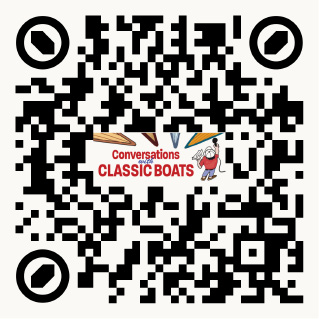
Scan here to listen to the author’s Conversations with Classic Boats podcast.
Tom Darling is the host of Conversations with Classic Boats, “the podcast that talks to boats.” Tune in via Apple Podcast, Google Podcast or Spotify, or online at conversationswithclassicboats.com.




